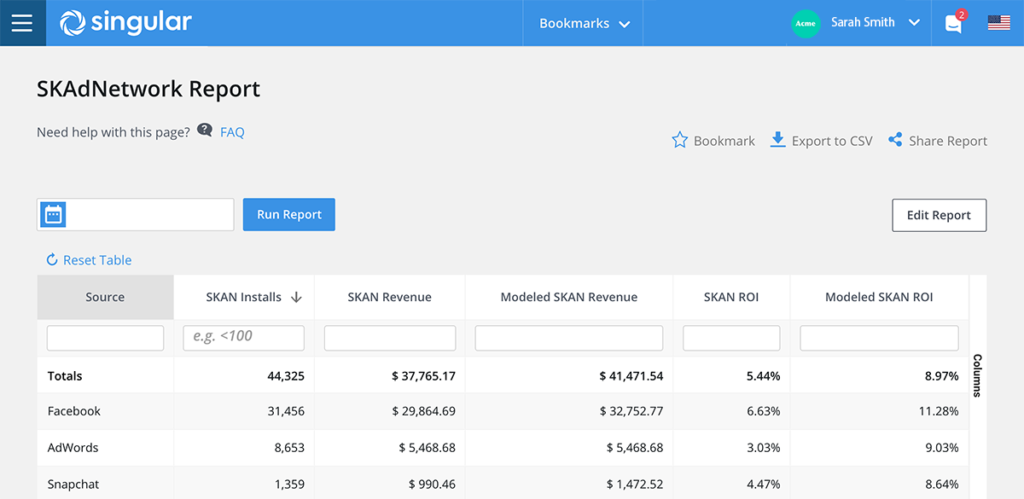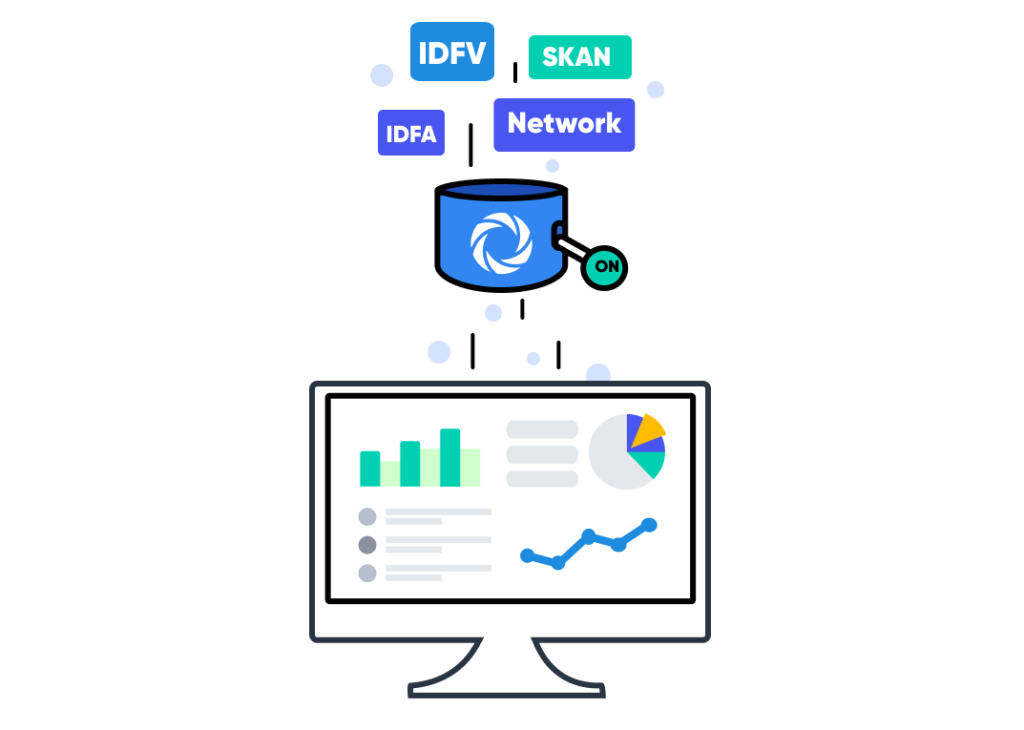The future of iOS mobile measurement
The future of mobile measurement on iOS is a single view that brings back KPIs, cohorts, and ROAS analysis. Marketers want a single source of truth for iOS like they once had, and I think we’ll be able to provide it.
Of course, there’s mileage to travel before we get there.
While we can’t predict exactly what SKAdNetwork changes are coming, I think we can all agree that the split between SKAdNetwork and MMP data that inherently exists today is not good enough. But, there’s good reason to have hope that it will improve, and that mobile marketers will have the data, insights, and tools they need to optimize growth.
Where we are today: mobile measurement on iOS
Over the past year, many of the fundamental truths we’ve known about mobile app attribution have changed. User acquisition teams learned a brand new set of terms, definitions, and best practices. The mechanics of how you optimize campaigns — and even how you run campaigns — is now different.
Wishfully, some parts of the industry, and perhaps not-so-small parts of it, have seen the iOS changes and the new Apple privacy policies as no more than a technical hurdle. But as we’ve seen throughout the year, SKAdNetwork is here to stay.
Recognizing this leads to an obvious conclusion – we are in need of new technology.
Apple has laid out the basics. There is a way to get attribution on iOS, but it’s neither as good nor as easy as it was with IDFA. The good news, however, is that there is plenty of technology potential out there, and that the measurement market is more competitive than ever. Solutions are coming.
MMPs’ evolving role in iOS marketing measurement
Not surprisingly, we’ve seen a vast change in MMP philosophy towards iOS measurement and SKAN over the past year.
Let’s be honest: even today, the vast majority of MMPs are not really ready when it comes to supporting advertisers with running and reporting on SKAN campaigns. However, in sharp contrast to the past, it’s clearly sensible to argue that the MMP is the optimal SKAdNetwork facilitator: running your conversion value updates against iOS devices and collecting all the SKAdNetwork data from your media partners. Plus, good SKAdNetwork systems will support as many measurement models as possible so your mobile app can best utilize the limited bitwise representation of conversion values that Apple has given us. And better SKAdNetwork systems will decode those conversion values back to the original events so that reporting makes sense to advertisers and they can optimize on actual KPIs.

I’m not shy to say that Singular has led the way in defining what is needed from a good SKAdNetwork system.
Early on, we defined (and then released) the common models we believed should be suitable for most mobile apps. We released multi-day measurement even when no ad network was supporting it, as soon as it became clear that doing so would help push the market to adopt this. We worked with partners to create powerful integrations that would help everyone exchange information on the relationship between the SKAdNetwork campaign and ad network campaigns, as well as define how in-app events are encoded to SKAdNetwork bits.
But today we are not going to talk about what a good SKAdNetwork system looks like. Today we are going to define what the best SKAdNetwork system will look like — even if it’s not quite available just yet.
An important first step: Fix the data
The first thing to acknowledge about SKAdNetwork data specifically and SKAdNetwork in general is that it’s hard. It is genuinely hard, and this is mostly because Apple has made it as such.
But we need to remember that this is a new framework, and we have to think in new terms. It is no longer about attributing a single user: small data sets that expose individual users are no longer supported, and SKAN’s random timers make it even harder to get information about individual users.
What this all means is that even if you’ve gone through the effort of implementing SKAdNetwork in your mobile apps and are running SKAdNetwork campaigns with partners, there is still a fairly decent chance that the data you see, likely in your MMP dashboard, can range between bad and non-usable.
That is horrible.
Let’s just be honest about it. It is really, really bad when marketers adopt the new standard, put in a ton of hard work, and see no reward for their efforts.
A lot of it is due to privacy thresholds as well as common errors that people are making when it comes to running SKAN campaigns. For our customers, we see Singular as a key piece in solving for that, and this is where our new technology comes in. In last week’s release, we announced SKAN Advanced Analytics and its first milestone – Modeled Metrics.
Modeled Metrics fixes the data gaps caused by privacy thresholds using data science and statistics.
It is not magic, but it is some very cool tech that allows our customers to worry less about the common SKAdNetwork pitfalls that would otherwise compromise SKAN data and enables them to just do their jobs. In other words, SKAN Modeled Metrics from Singular supplies clean, actionable insights that lets marketers make allocation and optimization decisions with a high degree of confidence that their data is complete.
The future of iOS mobile attribution: A single view
To understand where we are going with SKAN Advanced Analytics, let’s think about the potential for MMPs as a powerful technology provider for advertisers:
- Our SDK is in the app
- We operate SKAdNetwork updates
- We collect unattributed in-app data, and cover 100% of users
- We still collect attributed opt-in IDFA data for some apps/users, which typically covers 20-40% of users
- We collect SKAdNetwork data from all media partners via postbacks and APIs
- In Singular’s case, we also collect granular ad spend data that tells us where advertiser budgets are going in a very accurate way
Now, let’s think about the problem.
Marketers want reporting to be as it was, which means cohorted, full-funnel metrics, against every meaningful breakdown that can teach us something about the campaign.
Some breakdowns, such as creative, are not readily available by the framework. We expect these to either get added by Apple or supported indirectly by increasing the limits on skan_campaign_id. Improving the conversion model will improve the underlying accuracy. Combining the knowledge we have from all these siloed data sets should teach us a lot more than what we can learn based on the SKAdNetwork dataset alone.

As I mentioned initially, we can’t predict what changes Apple will make in SKAN.
We can argue, however, that the future of iOS measurement is a single view of marketing reality: a single source of truth that returns KPIs, cohorts, and ROAS analysis. And, a source of truth that offers predictive values for KPIs like revenue.
What that means: how we see iOS measurement evolving
As we’ve previously established, SKAdNetwork data is determined by the following aspects:
- The conversion model determines the underlying accuracy.
- For example, an optimized revenue model for an app with in-app purchases happening in the first 24 hours will generate better data than a basic six-event model that doesn’t optimize on value.
- In another example, a model that uses a 72-hour measurement period will generate better data for an app that has the vast majority of conversions happening in the first three days than a model that only looks at the first 24 hours.
- Statistical algorithms can aid in reconstructing partial data due to privacy thresholds and timer skews
- Predictive analytics can leverage multiple data sets collected by MMPs to create an easy to understand and easy to use report.
If we look at these components we can also imagine additional improvements:
- Machine learning can help cluster users better, thus further optimizing the conversion model to distinguish between high value and lower value users. We expect this to be common for Singular and other MMPs as the operators of the model.
- Machine learning and other technologies can help calculate the predictions of previously mentioned KPIs, and any improvement in the underlying data will further improve such predictions.
To summarize, we believe that over the next year iOS measurement will go through a dramatic change. SKAdNetwork will continue to grow in adoption as the de facto standard, and marketers that rely on non-compliant workarounds may find themselves lagging behind while others are taking advantage of the gigantic pool of growth opportunity that is the iOS ecosystem.
We do recognize that supportingSKAdNetwork for the past year has been quite taxing, but these new technologies provide our advertisers with a real edge. The simple fact is that advertisers that use MMPs that are betting against SKAdNetwork will be left behind.
It is only a question of when.
As technologists, we are excited by the enormous opportunity that lies ahead of us. We are going to be building a lot in this upcoming year, and we can hardly wait to reveal what will be coming next.
What’s next, and how to get better insights yourself
We are only getting started with SKAN Advanced Analytics, and the recent release, SKAN Modeled Metrics, already gives our customers improved visibility to SKAN performance. Stay tuned for our upcoming posts that provide more detail.
In the meantime:
If you want to take ownership of your iOS marketing measurement or have more questions, schedule some time with one of our product experts.
Stay up to date on the latest happenings in digital marketing


